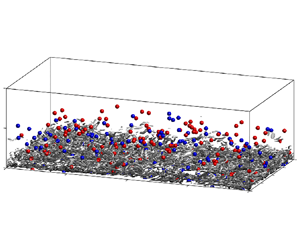Published online by Cambridge University Press: 13 July 2023

In dispersed two-phase flows, particle electrification is a prevalent phenomenon that plays a crucial role in particle transport. However, the influences of electrostatic forces on particle behaviour in wall-bounded turbulent flows, especially in bidisperse cases, is not well understood. In this study, using direct numerical simulations based on a coupled Eulerian–Lagrangian point-particle approach at friction Reynolds number  $Re_\tau =550$, we demonstrate that when the electrostatic Stokes number is of the order of
$Re_\tau =550$, we demonstrate that when the electrostatic Stokes number is of the order of  $O(10^{-1})$, electrostatic forces could considerably alter particle behaviour in both monodisperse and bidisperse particle-laden turbulent channel flows. Specifically, the wall-normal profiles of the particle concentration are determined by the competition of turbophoresis, biased sampling and electrostatic effects. The electrostatic forces are found to reduce the concentrations of lighter particles by electrostatic drift directly, whereas they alter those of heavier particles by strengthening turbophoresis indirectly. With increasing electrical charge, the dynamics of the lighter particles remains approximately unchanged, but that of the heavier particles is modulated significantly due to their relatively strong particle–electrostatic interaction. In the near-wall region, electrostatic forces tend to homogenize the distribution of lighter particles in the spanwise direction by inhibiting the formation and destruction of particle clusterings and voids, thereby maintaining the anisotropic streaky clusterings. Furthermore, even though the clustering dynamics remains unchanged, the spatial extents of the clusterings at the channel centreline are suppressed (enhanced) by a factor of two, probably due to the remarkable reduction (increase) of particle concentration in this layer.
$O(10^{-1})$, electrostatic forces could considerably alter particle behaviour in both monodisperse and bidisperse particle-laden turbulent channel flows. Specifically, the wall-normal profiles of the particle concentration are determined by the competition of turbophoresis, biased sampling and electrostatic effects. The electrostatic forces are found to reduce the concentrations of lighter particles by electrostatic drift directly, whereas they alter those of heavier particles by strengthening turbophoresis indirectly. With increasing electrical charge, the dynamics of the lighter particles remains approximately unchanged, but that of the heavier particles is modulated significantly due to their relatively strong particle–electrostatic interaction. In the near-wall region, electrostatic forces tend to homogenize the distribution of lighter particles in the spanwise direction by inhibiting the formation and destruction of particle clusterings and voids, thereby maintaining the anisotropic streaky clusterings. Furthermore, even though the clustering dynamics remains unchanged, the spatial extents of the clusterings at the channel centreline are suppressed (enhanced) by a factor of two, probably due to the remarkable reduction (increase) of particle concentration in this layer.